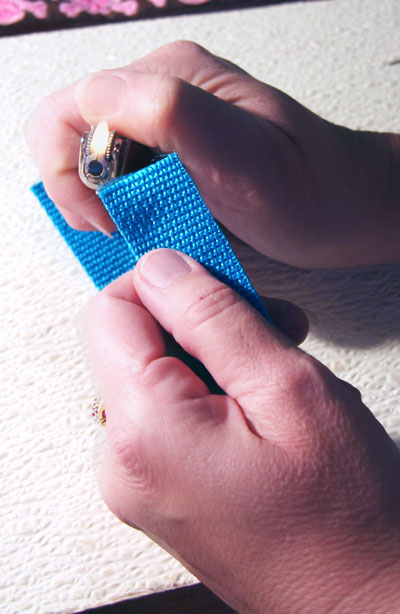How To Cut Webbing
You can cut webbing quickly to the size you need for any project. Webbing is a strong woven material made from nylon, polypropylene, cotton, and poly-elastic blends. It has a variety of uses that take advantage of its lightweight strength and pliability. These include seat belts, safety harnesses, bag handles, pet collars, and clothing applications.
Webbing has a tendency to fray quickly if the ends are not sealed after cutting. Hence, most larger businesses use industrial web-cutting machines which feature a hot blade that slices and seals at the same time. When you have a small home project, or you are just starting your business in your kitchen, you can still achieve professional results with the following technique.
Things you'll need:
- A Ruler
- A Permanent Marker
- A Pair of Sharp Steel Scissors
- A Lighter
- A Pair of Pliers
Step 1:
Unroll your spool of webbing and measure the length you want to cut. Mark your measurement with the marker, and then remeasure it to ensure an accurate cut. Always measure twice and cut once!
Step 2:
Use the scissors to cut your webbing along the mark. Try to cut with a single, fluid motion to avoid jagged edges.
Step 3:
Note: Skip this step if you are using a natural fiber webbing, like cotton.
Now take your lighter and apply enough heat to melt the edge. Polypropylene webbing may catch fire if it gets too hot but you can easily blow it out to avoid any serious damage to the material.
Step 4:
While the edge is still warm, use the pliers to compress the ends of the fabric together. This will help seal them and should keep the material from unraveling after heavy use.


Step 3 - Melt the Edge



Craft Difficulty Scale
You can cut webbing quickly to the size you need for any project. Webbing is a strong woven material made from nylon, polypropylene, cotton and poly-elastic blends. It has a variety of uses that take advantage of its lightweight strength and pliability. These include seat belts, safety harnesses, bag handles, pet collars, and clothing applications.
Webbing has a tendency to fray quickly if the ends are not sealed after cutting. Hence, most larger businesses use industrial web-cutting machines which feature a hot blade that slices and seals at the same time. When you have a small home project, or you are just starting your business in your kitchen, you can still achieve professional results with the following technique.
Things you'll need:
- A Ruler
- A Permanent Marker
- A Pair of Sharp Steel Scissors
- A Lighter
- A Pair of Pliers
 Step 3 - Melt the Edge
Step 3 - Melt the EdgeStep 1:
Unroll your spool of webbing and measure the length you want to cut. Mark your measurement with the marker, and then remeasure it to ensure an accurate cut. Always measure twice and cut once!
Step 2:
Use the scissors to cut your webbing along the mark. Try to cut with a single, fluid motion to avoid jagged edges.
Step 3:
Note: Skip this step if you are using a natural fiber webbing, like cotton.
Now take your lighter and apply enough heat to melt the edge. Polypropylene webbing may catch fire if it gets too hot but you can easily blow it out to avoid any serious damage to the material.
Step 4:
While the edge is still warm, use the pliers to compress the ends of the fabric together. This will help seal them and should keep the material from unraveling after heavy use.